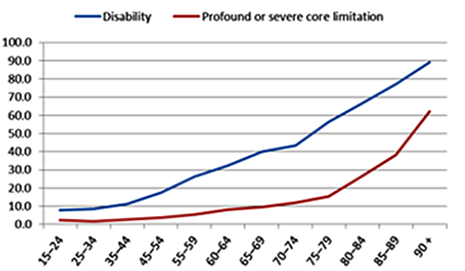AT AN ANNUAL cost of around $40 billion, the age pension is the federal government’s largest single social security program, and age pensioners account for around half of all Australians receiving social security benefits. So it’s not surprising that the speculation about cuts in welfare spending has focused on this payment, and specifically on the possibility that the qualifying age could age rise to seventy and that future increases in pension rates might be linked to prices rather than wages.
The treasurer, Joe Hockey, has argued that the pension age “was set at that level in Australia in 1908 when life expectancy was fifty-five… Now life expectancy is eighty-five and as of today, it’s still pension age sixty-five.” But would raising the pension age be fair – and, just as importantly, would it be a practical and effective means of meeting current and future budget challenges?
The budget challenge
A common way of looking at the budget implications of an ageing population is to consider changes in the “age support ratio” - the ratio of potential workers to people of pension age. According to Treasury’s most recent Intergenerational Report, the age support ratio is projected to fall over the next three or four decades. In 2010, there were five people of working age for every person aged sixty-five and over; by 2050, says Treasury, that figure will have fallen to 2.7.
Everything else being equal, this means that the cost of financing any given level of pension payment will be greater. A halving of the support ratio, for instance, implies that the taxes required to fund age pensions would roughly double for each person of working age at that point in the future. (For the moment, we’ll ignore the fact that these future workers are likely to be better-paid than current workers.)
If the government wishes to achieve and maintain a budget surplus, total taxes would need to increase (the cost of age pensions is already more than 10 per cent of total Commonwealth tax revenue), spending on other budget items would need to fall or the level of age pension per recipient would need to be cut.
Population ageing also has implications for other parts of the federal budget. Older people are likelier to use the healthcare system, and if they are eighty-five or older they are much more likely to need long-term care. On that basis, the Intergenerational Report estimates that spending on health is projected to rise from 4 per cent to 7.1 per cent of GDP by 2049–50 and aged care is projected to rise from 0.8 per cent of GDP to 1.8 per cent.
Would increasing the pension age be fair?
The attraction of increasing the pension age is that it has the potential to adjust both sides of the support ratio simultaneously. If people stay in paid work rather than claiming the age pension, then the numerator (people in work) rises, while the denominator (people on pensions) falls, achieving a double whammy. If people spend more time in paid work they are also likely to save more through the superannuation system, raising their living standards in retirement.
It is for these and related reasons that bodies like the OECD and the European Commission have been arguing for increased labour force participation for older workers for a number of years.
Any assessment of the fairness of a policy proposal, however, should take into account how a specific reform proposal compares with other options. As Daniel Nethery has pointed out, the changes to the indexation of pensions canvassed by the treasurer would cause pensions to fall relative to community incomes. Over a thirty-five- to forty-year period the difference in future retirement incomes would be very large, eventually approaching a 50 per cent cut in payment levels relative to current indexation, with significant implications for poverty in retirement. Australia would then face the same problem with pensions that we currently face with Newstart – people reliant on pensions for their main income source would become increasingly impoverished compared to those in work.
Increases in the pension age need not have a direct impact on pension incomes. But they may reduce the period over which age pensioners receive the payment, and thus reduce what the OECD calls “future pension wealth,” which it defines as the ratio of the “lifetime flow of retirement incomes” to average earnings. In these circumstances, pension wealth is cut even if the amount received per year is unchanged.
Would this reduction in pension wealth be fair? In this context, one of the most important factors to remember is that life expectancy varies across the population and the majority of people don’t actually live as long as “average” life expectancy would suggest.
In the case of the United States, Barry Bosworth has estimated that there is a gap of roughly ten years in life expectancy at age fifty-five between rich and poor for both men and women born in 1940. In other words, men and women born in 1940 who were in the richest 10 per cent of the population in the middle of their working career could expect to live to just over ninety years, while life expectancy for men and women who had been in the poorest 10 per cent of workers would be around eighty years. This would mean that if the retirement age was increased to seventy then rich Americans could expect to collect social security pensions for twice as long as the poor.
Astonishingly, Bosworth’s study finds that life expectancy for the bottom 40 per cent of women in the United States actually declined between those born in 1920 and those born in 1940.
Research by the Office of National Statistics in England and Wales concluded that inequalities in male life expectancy caused by socioeconomic circumstances increased during the past twenty-five years despite improvements over time for all classes. At age sixty-five, the life expectancy of males classified by occupation as “higher managerial and professional” was 18.8 years, compared with 15.3 years for those assigned to occupations classified as “routine.” At the same age, the life expectancy of females classified by occupation as “higher managerial and professional” was 21.7 years, compared with 18.5 years for those assigned to occupations classified as “routine.” While the gap increased more rapidly for women, there were improvements in life expectancy for all income groups.
In Australia, the most striking discrepancy is between Indigenous and non-Indigenous life expectancies. In 2005–07, according to the Australian Bureau of Statistics, life expectancy at birth for Aboriginal and Torres Strait Islander males was 67.2 years, 11.5 years less than that for non-Indigenous males (78.7 years). For Aboriginal and Torres Strait Islander females, life expectancy at birth was 9.7 years less than for non-Indigenous females (72.9 years and 82.6 years respectively).
On average, in other words, Indigenous men couldn’t expect to reach a new pension age of seventy and Indigenous women would receive the age pension for less than a quarter of the time that non-Indigenous women would. (A good deal of the difference in life expectancies is due to the fact that Indigenous men and women aged sixty-five or less have much higher mortality rates, so that even now a significant number don’t live long enough to claim an age pension.)
Across the population as a whole, the Australian Institute of Health and Welfare found differences in life expectancy between major cities and very remote regions in Australia of nearly seven years for men and six years for women – although most of this is due to differences in the share of people who are Indigenous.
A recent Australian study by Philip Clarke and Andrew Leigh found that at age sixty the difference between life expectancy for those in the highest income quintile and the lowest income quintile was five years for men and 5.4 years for women, with men in the lowest quintile expected to live to just over seventy-eight years and women in the same income group to eighty-three years.
These differences are significantly less than the figures for the United States, although this is at least partly because the American estimates are broken down into smaller groups (deciles) and thus pick up more of the disparities at the top and bottom of the income distribution. Comparing the second and eight deciles (rather than the poorest and richest) would reduce the US disparities to about seven years for both men and women, still greater than in Australia.
On the surface, this suggests that higher-income groups in Australia could get a pension for about half as many years again as would lower-income groups if the pension age was increased to seventy. But there is one factor – unique to Australia among rich countries – that would offset this: we are the only OECD country where the public pension is income-tested and excludes most of the highest-earning 20 per cent of people over sixty-five.
The effects are also likely to be less severe in Australia than in the United States in particular because differences in life expectancy do not appear to have as steep a gradient with income, and because Australia’s income-tested pension system distributes public spending on pensions more progressively than many other countries’. The relative disparities in pension wealth are much more significant in the case of Indigenous people, however, although possibly the better way to think about this is to ensure that we become much more effective in reducing the life-expectancy gap between Indigenous and non-Indigenous Australians.
To sum up, increasing the pension age potentially has an adverse effect in equity terms. An increase in the pension age reduces the pension wealth of lower-income groups proportionately more than it reduces the pension wealth of higher-income groups.
Would increasing the pension age be effective?
Apart from the equity problems, it is equally important to ask whether increasing the pension age is an effective way of addressing current and future budget challenges.
In terms of immediate fiscal concerns, it would have no effect on the current budget deficit because the rise is unlikely to commence during the next eight years. As part of the 2009 pension reforms, the Rudd government announced an increase in the pension age from sixty-five to sixty-seven, starting in 2017 and fully phased in by 2023. If the pension age were raised to seventy at the same rate, the change would not be fully effective until 2032. It’s possible to increase the pension age at a faster rate – say by six months every year – but this would still not see the pension age reaching seventy until 2029; this means that most of the baby boomers born before 1959 or 1962 (depending on the speed of increase) would not be affected. Increasing the pension age is not a solution to current problems; it is a contribution to meeting challenges in the 2020s and 2030s.
It has been argued that if Australia lifts the pension age to seventy, Australians will have some of the oldest workers in the world. According to the most recent edition of the OECD’s Pensions at a Glance, seventeen out of the thirty-four OECD countries have legislated for increases in pension ages above sixty-five. Only Iceland and Norway are currently at sixty-seven, but Australia, Denmark, Germany and the United States have plans to match them, and Britain has announced an increase to sixty-eight.
Most OECD countries have provision for early retirement, however, including Australia, which allows access to superannuation from sixty years of age. So it would be important to consider increasing the superannuation preservation age, which allows those with sufficient super to retire at sixty and potentially avoid the effects of an increase in the pension age. And to the extent that higher-income people are able to run down their super during this period of early retirement and then claim some or all of the age pension, concerns about fairness become more salient.
In considering the effects of pension rules, however, a better measure is what the OECD calls the “effective age of labour market exit” – the average age at which workers are no longer participating in the labour market. (This is estimated over a five-year period for workers initially aged forty or over.) Australia currently has the twelfth-highest effective exit age for men, at 64.9 years, while for women Australia ranks sixteenth-highest, at 62.9 years.
Many of the OECD members with higher effective exit ages are lower-income countries, including Mexico, Chile, Korea, Portugal and Israel, though in Japan the average exit age for men is over sixty-nine years and for women it is close to sixty-seven years. This suggests considerable scope for Australia to increase effective ages of labour force exit, if it aimed to match Japan.
Would increasing pension ages be effective in increasing employment at older ages?
Part of the objective is to have an indirect effect earlier in people’s working lives. If people now in their forties or early fifties know that they won’t be able to claim an age pension until they are seventy, they may adjust their retirement planning and savings behaviour and extend their working lives. For any such effect to occur, however, it would be necessary to have complementary policies that support people in balancing their work and caring responsibilities, in particular.
But it’s important to recognise that there appears to be little correlation between official and effective ages of retirement. Norway, for example, already has a higher official pension age than Australia but a slightly lower effective age of labour force exit. The vast majority of countries with low effective ages of labour force exit have the same official pension age as Australia currently has; at the extreme, Luxembourg has a pension age of sixty-five but an effective exit age for men of 57.6 years.
Specific national experiences do suggest, however, that increasing the pension age can have a significant effect on employment at older ages and also on how many people receive social security payments. New Zealand increased its age of eligibility for its public pension scheme, National Superannuation, from sixty to sixty-five years between 1992 and 2001. Research by the Melbourne Institute found that there was clear increase in employment rates in this age group due to the policy change. But it also noted that only 40 per cent of middle-aged couples in New Zealand had private or employer-sponsored superannuation at the time, with a low median value of $30,000 – meaning that there were limited alternatives for many people approaching pension age. Earlier research also suggested that the effect was due to the fact that older workers who already had jobs stayed in employment.
Closer to home, Australia increased the age pension age for women from sixty to sixty-five years between 1995 and 2013. According to the ABS, the labour force participation rate of women in this age group increased from 16.6 per cent to 45.6 per cent in this period. Research at the University of Sydney found that an increase in the pension eligibility age of one year for women induced a decline in the probability of retirement of approximately 10 per cent, but also increased enrolment in other welfare programs, especially disability pension, or DSP.
While the number of women aged sixty to sixty-four who received the DSP increased very significantly over the period, the net effect was a very large fall in receipt of social security payments, from around 60 per cent of women in the age group in the mid 1990s to around 20 per cent currently.
This experience might suggest that raising the pension age could potentially have a major impact in restraining welfare costs, but there are reasons to be cautious about whether past trends are necessarily likely to have the same effect in the future.
As shown in the chart below, disability is strongly related to age. Although it remains around 10 per cent of the population up to the age of forty-five years, it increases rapidly to more 40 per cent by the age of seventy. Overall DSP rates fall between the two prevalence rates shown here, being closer to the rates of profound or severe core limitation than to overall disability rates. Nevertheless, it is clear that a higher proportion of those aged sixty-five to sixty-nine years could be expected to have a disability than among those aged sixty to sixty-four years, suggesting that future increases in the pension age are likely to have diminishing returns compared to past reforms.
Chart 1: Prevalence of disability by age, Australia, 2012

Source: ABS, Disability, Ageing and Carers, Australia: Summary of Findings, 2012.
Which crisis?
Increasing the pension age is likely to be just one part of any set of reforms to address the challenges of population ageing. While it could be expected to have a positive impact on the budget balance it is implausible that it could fill the gap by itself. Many complementary policies will need to be considered, including a requirement that superannuation be taken in the form of lifetime annuities to ease the pressure on age pensions. New ways of financing long-term care would also appear to be essential in preparing for population ageing.
Moreover, as recently pointed out by Veronica Sheen, obtaining and maintaining employment in later life is not straightforward. The loss of a job, and difficulties finding another, tend to precipitate a decision to retire. Age discrimination barriers are significant and need to be addressed. Work-life balance issues become more sharply defined with age.
Increased workforce participation among older people also has potential costs in other important areas of social life. Women’s lower participation in the labour force partly reflects their greater family responsibilities (looking after elderly parents, for example). Workforce practices that allow these responsibilities to be more effectively shared between men and women will need to be developed.
More fundamentally, it isn’t clear that the federal government’s budget challenge is primarily caused by the level of spending on age pensions. Australia currently has the fourth-lowest level of public pension spending of any OECD country and is projected by 2050 to have the third-lowest level of pension spending.
Where Australia is unusual is that it has by far the highest level of tax concessions for private pensions in the OECD, at four times the OECD average, and people of pension age pay much lower taxes than workers at the same level of gross income.
A fair and effective approach to the challenges of population ageing would involve much more than increasing the pension age. •




